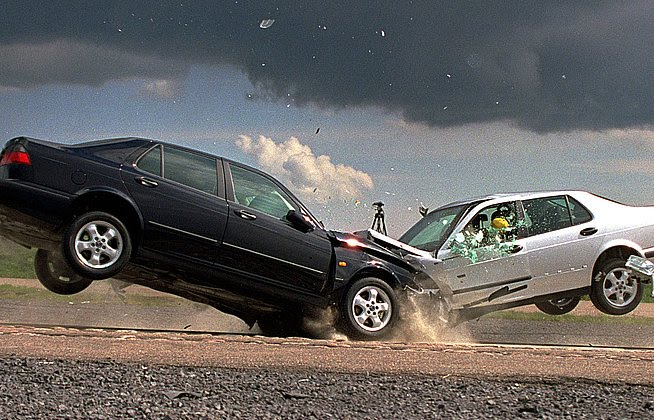Car collision is a common occurrence in every part of the world. Some do not cause serious injuries, while the others are fatal. According to the Association for Safe International Road Travel, an average of 3287 people die in road accidents each day. India specifically ranks high in road accidents – 1214 road crashes occur every day. The daily death toll due to road accidents is four times higher than the death toll from terrorism or natural calamities. According to the figures released by the government, more than 1,46,133 people were killed as a result of crashes in 2015 alone. It is not just India; accidents are the third leading cause of death for males in the United States.
The Physics of car accidents can be best described using Newton’s Laws. Newton’s law fundamentally describes the response or motion of a body when forces act upon it. Isaac Newton compiled the three laws of motion in his book Philosophiae Naturalis Principia Mathematica, often referred to simply as the Principia.
Energy Created During Motion
When driving down the roads, the vehicles are moving with certain velocity and direction. In addition, all vehicles have weight and mass depending on whether it is a motorbike, SUV or a truck. When the vehicles are moving at a certain speed, energy is created by virtue of their mass and forward velocity. The energy created is called Kinetic energy, which is formulated as,
![]()
where,
m is the mass of the vehicle, and
v the forward velocity of the moving vehicle.
The mass of the vehicle remaining constant, a certain quantity of kinetic energy is created depending on the speed with which the vehicle is moving. The kinetic energy of the vehicle increases when a person accelerates the vehicle to a higher velocity.
The Collision Physics
Newton’s Second Law of Motion given by F = ma, governs the physics of a collision between two bodies. The vehicles possess a high amount of kinetic energy while moving at high speed. During the collision, the time of impact is very brief and is called an Impulse. The forces generated due to this very brief impact of time intervals are called Impulsive forces. The second law of motion can be restated as,
![]()
where, v is the velocity and t the time in seconds.
From the mathematical equation, it is evident that the short elapsed time interval during a collision causes the contact forces between the vehicles to be very high. Forces can be produced at impact to the order of tens of thousands, to hundreds of thousands Newton, depending on the mass of the vehicles and their velocity at impact. When two vehicles have a head on collision, both the bodies absorb kinetic energy, collapse, and crush inward. The distance formula, d = vt ( t = d/v) is used to calculate the elapsed time of the impact between two vehicles. Thus, we can infer why a vehicle incurs the maximum damage during a severe high-speed collision. In some cases, the collision forces are so violent that a vehicle's body is literally torn into two large pieces.
What happens to passengers inside?
Every object in a state of uniform motion tends to remain in that state of motion unless an external  force is applied to it, explains why passengers in cars are thrown forward or backward in a collision, which usually results in a sudden acceleration or deceleration of the vehicle, causing further damages. Initially, both the car and the passengers are moving forward at a particular speed. When a collision occurs, the speed of the car is slowed down very quickly, leaving the passengers’ upper part of the body, still in the forward motion. However, the lower part of the body, anchored to the seat, has come to rest abruptly. Hence, the person is jerked forward.
force is applied to it, explains why passengers in cars are thrown forward or backward in a collision, which usually results in a sudden acceleration or deceleration of the vehicle, causing further damages. Initially, both the car and the passengers are moving forward at a particular speed. When a collision occurs, the speed of the car is slowed down very quickly, leaving the passengers’ upper part of the body, still in the forward motion. However, the lower part of the body, anchored to the seat, has come to rest abruptly. Hence, the person is jerked forward.
Two factors determine the force with which the body is thrown forward:
- The speed of the vehicle – Greater the speed of the car on impact, greater is the force acting on the car passengers and higher is the intensity of forward jerk.
- The hardness of the body of the car – If the body of the car is made of a very hard metal, then a short time is taken for the whole car to come to a complete stop, as it will not crumple. With decrease in time, the rate of deceleration of the car would be fast, hence greater force acting on the passenger, jerking them forward fiercely.
The precautionary measure is a restraining device, like a seat belt. However, seat belts are not always the perfect solution. Though it can restrain a torso effectively, your head will bang on the steering wheel and fatal injuries would be caused.  An airbag, however, can prevent the head from swinging through the whole range of motion and damaging the neck. Additionally, crumple zones with rigid cabs are now a standard in every car throughout the world as a safety measure. Crumple zones are structural areas in the front and sometimes rear of a vehicle. The goal is, when car crashes, the structure crashes in a relatively gradual way that absorbs, much of the impact energy, keeping it away from the occupants in what is termed as the controlled crash. Conversely, the force experienced is greater if the time to stop is shorter. Crumple zones add time to the crash by absorbing energy, thus causing less damage.
An airbag, however, can prevent the head from swinging through the whole range of motion and damaging the neck. Additionally, crumple zones with rigid cabs are now a standard in every car throughout the world as a safety measure. Crumple zones are structural areas in the front and sometimes rear of a vehicle. The goal is, when car crashes, the structure crashes in a relatively gradual way that absorbs, much of the impact energy, keeping it away from the occupants in what is termed as the controlled crash. Conversely, the force experienced is greater if the time to stop is shorter. Crumple zones add time to the crash by absorbing energy, thus causing less damage.
However, as the old adage goes, prevention is always better than cure. Avoid reckless driving on roads and make it a habit to follow the traffic laws diligently.
